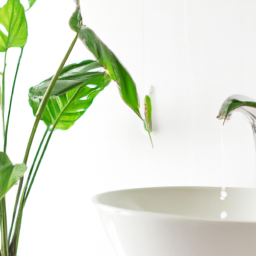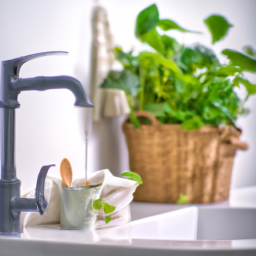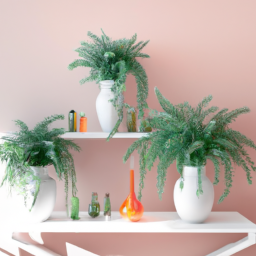
Are you looking to add a touch of nature to your bathroom? Greening up your bathroom with plants is not only a visually appealing way to decorate, but it can also improve the air quality and create a soothing environment. In this blog post, we will explore the best plants for humid environments, specifically tailored to thrive in the unique conditions of your bathroom. So, if you’re ready to bring a little bit of the outdoors inside, keep reading to discover the perfect plants that will thrive in your bathroom’s humidity.
Benefits of Incorporating Plants in Your Bathroom for a Greener Environment
Welcome to our guide on greening up your bathroom with the best plants for humid environments! In this article, we will explore the numerous benefits of incorporating plants in your bathroom, not only for aesthetic purposes but also for creating a healthier and greener environment. So, let’s dive right in!
Improving Air Quality
One of the most significant benefits of having plants in your bathroom is their ability to improve air quality. Bathrooms are often filled with moisture, which can lead to the growth of mold and mildew. However, certain plants are natural air purifiers and can help remove toxins and impurities from the air, making your bathroom a healthier space.
Plants such as the Boston Fern, Spider Plant, and Peace Lily are excellent choices for bathrooms due to their ability to thrive in high humidity environments. These plants have been proven to effectively remove pollutants like formaldehyde, benzene, and xylene from the air, which are commonly found in household products.
Moreover, the presence of plants in your bathroom can also help reduce unpleasant odors. Plants naturally absorb odors and release oxygen, creating a fresher and more pleasant bathroom environment for you and your guests.
Reducing Stress and Enhancing Well-being
Another remarkable benefit of incorporating plants in your bathroom is their ability to reduce stress and enhance overall well-being. Bathrooms are often considered as sanctuaries, where we can relax and unwind after a long day. By adding plants to this space, you can create a soothing and calming atmosphere.
Studies have shown that being around plants can help lower blood pressure, reduce anxiety, and improve mood. The color green, which is abundant in plants, has a calming effect on our minds and can promote a sense of tranquility. So, having a bathroom filled with lush greenery can truly transform it into a serene oasis.
Furthermore, taking care of plants can be a therapeutic activity in itself. The act of watering, pruning, and tending to your bathroom plants can provide a sense of purpose and fulfillment, helping you unwind and reconnect with nature.
Enhancing Aesthetics and Ambiance
Aside from the health benefits, incorporating plants in your bathroom can greatly enhance its aesthetics and ambiance. Bathrooms are often overlooked when it comes to interior design, but adding plants can instantly breathe life into this space.
There is a wide variety of plants that thrive in humid environments and can add a touch of elegance to your bathroom. The Snake Plant, Aloe Vera, and Orchids are just a few examples of plants that not only thrive in high humidity but also have visually appealing foliage and flowers.
Additionally, plants can help soften the hard lines and surfaces commonly found in bathrooms. They can provide a sense of warmth and natural beauty, creating a more inviting and cozy atmosphere. So, don’t hesitate to experiment with different plant arrangements and sizes to find the perfect fit for your bathroom.
In conclusion, incorporating plants in your bathroom can bring numerous benefits, ranging from improving air quality and reducing stress to enhancing aesthetics and ambiance. By carefully selecting plants that thrive in humid environments, you can create a greener and healthier space that you’ll enjoy spending time in. So, why not start greening up your bathroom today and experience the wonders of nature firsthand?

Greening Up Your Bathroom: Best Plants for Humid Environments
Welcome to our guide on how to transform your bathroom into a lush and green oasis. Bathrooms are often humid environments due to the moisture generated from showers and baths. This increased humidity can create the perfect conditions for certain plant species to thrive. In this article, we will explore the top plant species that are well-suited for humid bathroom conditions. So, let’s dive in and discover the perfect green companions for your bathroom!
1. Peace Lily
The Peace Lily (Spathiphyllum) is a popular choice for bathrooms due to its ability to thrive in high humidity. This elegant plant features glossy green leaves and beautiful white flowers, adding a touch of serenity to your bathroom. Peace Lilies are known for their air-purifying qualities, making them an excellent choice for improving indoor air quality.
When caring for a Peace Lily in your bathroom, it’s important to place it in a spot with indirect light. Direct sunlight can scorch the leaves, so opt for a location near a window that receives filtered light. Keep the soil consistently moist, but avoid overwatering as this can lead to root rot. Regular misting can also help maintain the humidity levels that Peace Lilies love.
With proper care, your Peace Lily will not only thrive in your bathroom but also provide a calming and refreshing atmosphere.
2. Boston Fern
The Boston Fern (Nephrolepis exaltata) is another fantastic choice for humid bathroom environments. Known for its feathery fronds that gracefully arch over its pot, the Boston Fern can add a touch of elegance and vibrancy to your bathroom space.
When it comes to caring for a Boston Fern, it’s crucial to provide it with high humidity levels. Bathrooms are naturally humid, but you can enhance the humidity by placing a tray of water near the plant or using a humidifier. This plant prefers bright, indirect light, so consider placing it near a window with filtered sunlight. Keep the soil consistently moist, but avoid waterlogging, as this can cause root rot.
Regularly misting the fronds can help prevent them from drying out in low humidity conditions. With its lush foliage and air-purifying qualities, the Boston Fern is an excellent choice for greening up your bathroom.
3. Spider Plant
The Spider Plant (Chlorophytum comosum) is a resilient and adaptable plant that thrives in a wide range of conditions, including humid bathrooms. This plant features long, arching leaves with white stripes, creating a visually appealing display.
Spider Plants can tolerate a variety of light conditions, from bright indirect light to lower light levels. This makes them versatile for different bathroom setups. However, avoid placing them in direct sunlight, as it can scorch the leaves.
When it comes to watering, Spider Plants prefer to dry out slightly between waterings. Overwatering can lead to root rot, so it’s important to let the top inch of soil dry out before watering again. Spider Plants are known for producing “spiderettes” or small offshoots that can be propagated into new plants, allowing you to expand your green collection.
Conclusion
Transforming your bathroom into a green haven is not only visually appealing but also beneficial for your well-being. The top plant species mentioned in this guide, including the Peace Lily, Boston Fern, and Spider Plant, are well-suited for humid bathroom conditions and can thrive with proper care.
Remember to consider the lighting conditions in your bathroom, provide adequate humidity, and maintain proper watering practices for each plant species. With a little effort and attention, you can create a serene and refreshing bathroom space that brings nature indoors.

Greening Up Your Bathroom: Best Plants for Humid Environments
Welcome to our guide on how to green up your bathroom with the best plants for humid environments. Bathrooms can often be challenging spaces for plants due to their high humidity levels. However, with the right selection and proper care, you can create a lush and refreshing oasis in your bathroom. In this article, we will provide you with a step-by-step guide on how to choose and maintain the perfect plants for your bathroom.
Tips for Maintaining and Caring for Bathroom Plants in a Humid Environment
1. Choose the Right Plants
When it comes to selecting plants for your bathroom, it’s crucial to choose species that thrive in humid environments. Here are some excellent options:
Aloe Vera: Aloe vera is a popular choice for bathrooms due to its ability to thrive in high humidity. It requires minimal care and can even help purify the air.
Spider Plant: Spider plants are known for their ability to tolerate a wide range of conditions, including high humidity. They have beautiful cascading foliage and are relatively low maintenance.
Peace Lily: Peace lilies are not only visually appealing, but they also thrive in high humidity. They can tolerate low light conditions, making them perfect for bathrooms with limited natural light.
2. Provide Adequate Light
While some bathroom plants can tolerate low light conditions, it’s essential to provide them with enough light to ensure their growth and vitality. Here are a few tips:
Place near windows: If your bathroom has windows, consider placing your plants near them to maximize natural light exposure. Be mindful of direct sunlight, as it can be too intense for some plants.
Use artificial lights: If your bathroom lacks natural light, you can supplement it with artificial grow lights. LED grow lights are energy-efficient and provide the right spectrum of light for plant growth.
Rotate plants: To ensure even light distribution, rotate your plants every few weeks so that all sides receive adequate light exposure.
3. Proper Watering and Drainage
Watering and drainage are crucial factors in maintaining healthy bathroom plants. Here’s what you need to know:
Check moisture levels: Before watering, check the moisture levels in the soil by inserting your finger about an inch deep. Only water when the top inch of soil feels dry.
Use well-draining pots: Choose pots with drainage holes to prevent water from accumulating at the bottom. This helps prevent root rot, a common issue in humid environments.
Avoid overwatering: Overwatering can be detrimental to your plants’ health. Ensure the excess water drains properly and avoid letting your plants sit in standing water.
4. Maintain Proper Humidity Levels
While bathrooms are naturally humid, it’s essential to maintain proper humidity levels to prevent mold and mildew growth. Here are some tips:
Use a dehumidifier: If your bathroom has excessive humidity, consider using a dehumidifier to regulate moisture levels. This can help create a healthier environment for your plants.
Mist your plants: Some plants benefit from regular misting to increase humidity around them. Use a spray bottle to mist the leaves, especially during drier seasons.
Group plants together: Grouping plants together can create a microclimate with higher humidity levels. This is particularly beneficial for plants that prefer more moisture.
By following these tips, you can create a thriving green space in your bathroom. Remember to choose plants that are suitable for high humidity, provide adequate light, water properly, and maintain the ideal humidity levels. With a little care and attention, your bathroom can become a refreshing sanctuary filled with vibrant and healthy plants.
Let’s bring it all home
If you’re looking to bring some life and freshness into your bathroom, why not consider adding some plants? Not only do they add a touch of greenery, but they also help to purify the air and create a calming atmosphere. However, not all plants thrive in the humid environment of a bathroom. In this blog post, we’ll explore some of the best plants that are perfect for greening up your bathroom.
One of the top choices for a humid bathroom is the Boston Fern. With its lush green foliage and delicate fronds, the Boston Fern thrives in the moist conditions found in bathrooms. It helps to naturally humidify the air, making it a great choice for those dry winter months. Another great option is the Snake Plant, also known as Mother-in-Law’s Tongue. This hardy plant can tolerate low light and high humidity, making it an ideal choice for bathrooms. Its tall, upright leaves add a touch of elegance to any space. Other suitable plants for humid environments include the Peace Lily, Spider Plant, and Aloe Vera. By incorporating these plants into your bathroom, you can create a serene and refreshing oasis.
FAQ Roundup:
Q1: What are the best plants for a humid bathroom environment?
A1: When it comes to greening up your bathroom, there are several plants that thrive in humid environments. Some of the best options include:
- Spider Plant
- Peace Lily
- Snake Plant
- Orchids
- Boston Fern
Q2: Why are these plants suitable for humid bathroom environments?
A2: These plants are well-suited for humid bathroom environments because they naturally thrive in high humidity levels. They are able to tolerate and even benefit from the moisture in the air, which makes them ideal choices for greening up your bathroom.
Q3: How do I care for plants in a humid bathroom?
A3: Caring for plants in a humid bathroom is relatively easy. Here are a few tips to keep in mind:
- Water the plants regularly, ensuring the soil remains moist but not waterlogged.
- Provide adequate light for the plants by placing them near a window or using artificial grow lights.
- Consider using a humidifier to maintain a consistent level of humidity in the bathroom.
- Regularly dust the leaves of the plants to ensure they can absorb sunlight effectively.
- Monitor the plants for any signs of pests or diseases and take appropriate action if necessary.
Q4: Can I place these plants in other rooms besides the bathroom?
A4: Absolutely! While these plants are well-suited for humid bathroom environments, they can also thrive in other rooms with high humidity levels, such as kitchens or laundry rooms. Just make sure to provide them with the appropriate care and conditions they need to flourish.
Q5: Are there any plants I should avoid placing in a humid bathroom?
A5: Yes, there are a few plants that may not fare well in a humid bathroom environment. Plants that prefer drier conditions or are sensitive to excessive moisture should be avoided. Examples include succulents, cacti, and plants that are prone to root rot. It’s always best to choose plants that are known to thrive in high humidity to ensure their health and longevity.
Dr. Olivia Green is a botanist with over two decades of experience in indoor plant cultivation. She holds a Ph.D. in Plant Biology and has dedicated her career to researching plant behavior in controlled environments. Dr. Green is passionate about helping plant enthusiasts master the art of indoor gardening through her extensive knowledge and practical insights.


